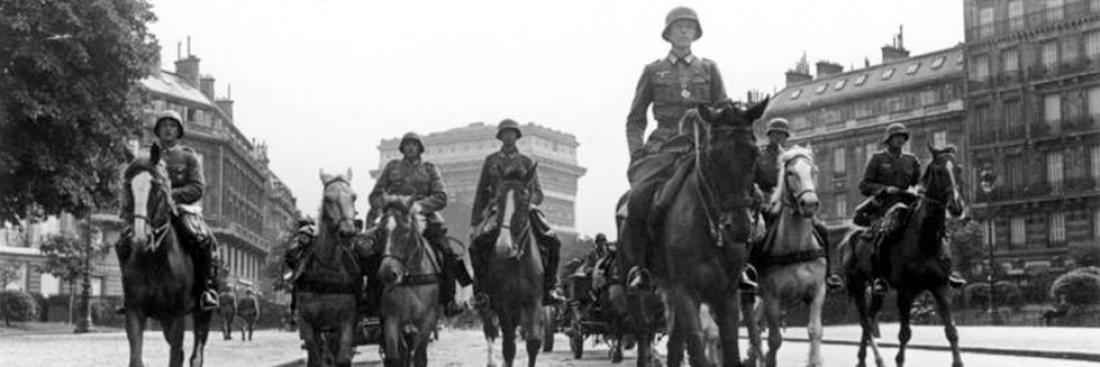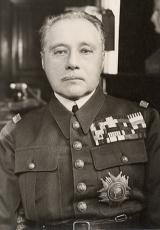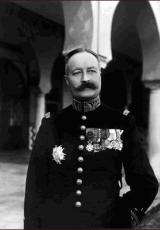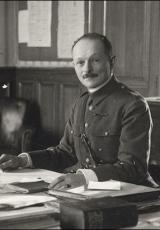L'invasion

Corps 1
On the 10th May the German army launched its general offensive on the Western Front. It resembled an updated version of their plan of 1914, with a broader sweeping movement that included the invasion of the Netherlands.
Corps 2
The Commander in Chief of the allied forces, General Gamelin, immediately set in motion the "Dyle manoeuvre", by sending troops into Belgium to face the enemy along the Anvers-Louvain-Gembloux-Namur front (the 1st army of General Blanchard, the 9th army of General Corap and the British corps of General Gort, whilst the 7th army of General Giraud were to advance as far as Breda to meet up with the Dutch army). On the 11th May first contact was made with the enemy by the advance units; the mechanised cavalry corps (General Prioux) covered the advance, allowing the 1st army to settle along the Wavre-Gembloux-Namur resistance point, its mission to provide cover until the 14th May. The battle of Gembloux was then to follow. Fierce fighting lasted throughout the 14th and 15th May, led by the 1st Moroccan division and the 15th motorised infantry division. But the 1st army received the order to retreat towards the Sambre river because of the tragic events on the Meuse 100 km further south.
On the 13th May, the principal German offensive was launched across the Ardennes, breaching French lines at Sedan the following day. On the 14th May the Meuse was crossed at Dinant, Givet, Monthermé and Sedan. Enemy armoured tanks advanced, supported by the attacking air force and managed to separate the 9th and 2nd armies. Counter attacks followed, mainly carried out by the 1st and 3rd reserve armoured divisions and the 3rd brigade of Sipahis etc. The fighting at Stonne proceeded with intensity. On the 18th May, the enemy seized the Maginot fortification of La Ferté where the garrison perished. The Germans changed direction towards the west and crossed the Ardennes canal; on the 16th May, General Guderian's tanks reached the Aisne valley, whilst in Belgium the group of allied armies was surrounded by three German armies. A counter attack at Montcornet with three battalions of tanks was in vain. On the 19th May Gamelin ordered a general counter-offensive but he was relieved of his command by Paul Reynaud, the head of the council and replaced by General Weygand, who decided to take defensive measures to save whatever he could. On the 25th May, the enemy took Boulogne-sur-Mer and on the 26th, Calais. The battle took place in Lille where the 4th army corps held out, with the survivors surrendering on the 31st May. In the meantime, the Belgian army became surrounded and surrendered on the 28th May.
In Dunkirk, the evacuation began by sea of the allied pocket, where 500,000 servicemen and 80,000 civilians were holed up without any provisions. On the 4th June, the Germans occupied the port and the town. 240,000 British soldiers, 115,000 French, 16,000 Belgians and Dutch were saved, but not their equipment. The French battle corps was annihilated.
The main enemy action was thus carried out against the defence mounted by Weygand. From the 23rd May, battles raged to the south of Amiens on the Dury plateau, where the colonials put up resistance. The unit commanded by de Gaulle counter attacked at Mont-de-Caubert on the Somme. At dawn on the 5th June the Germans took up the offensive again with 47 attacking divisions, the 6th, 7th and 10th armies. The battles were very brutal along the Aisne, the Somme and the Oise. The French front was breached at Condé-Folie, Dury and Roye. Within a few days, the 7th army was pushed back towards Beauvais and the Scottish units were surrounded at Saint-Valéry-en-Caux. The 6th army retreated behind the Aisne. On the 11th June, the third group of armies moved back towards Orléans. Paris was declared an open city. General Head Quarters was established in Briare, in the Loiret region. The Germans arrived in Paris on the morning of the 14th June. They had also reached Normandy.
On the 9th June, the enemy attacked the 4th army at Rethel. The Aisne was breached. Between the 11th and the 14th June, the Germans took Reims, Epernay, Châlons-sur-Marne, Provins, Saint-Dizier and Troyes. Their units fell back towards the south west and arrived in Besançon on the evening of the 16th. The 2nd, 4th and 6th French armies were surrounded in the East. The enemy arrived in Roanne, Mâcon, Bourg-en-Bresse and Pontarlier, threatening the army of the Alps. The companies of the Maginot fortifications, who had not carried out the general retreat, had been isolated and surrounded since the 14th June. They would resist at all costs. Dijon, Metz, Nancy, Epinal, Lunéville, and Strasbourg were taken. Toul surrendered after a desperate struggle. Along the Loire, which represented a natural defensive line, units defended the bridges. For example in Saumur, where cadets from the school of cavalry and from the Saint-Maixent and Fontainebleau schools, along with their supervisors, held up the enemy, as other soldiers did at Sully-sur-Loire and Jargeau etc. Columns of the invading forces stormed Alençon, Chartres, Le Mans and Laval, entering Brittany and reaching the Atlantic. Then followed the drama of Saint-Nazaire: 6,000 British soldiers embarked on the ocean liner Lancastria in a retreat evacuation, but the ship was bombed by German aircraft and quickly sank; this shipwreck caused about 5,500 deaths.
Between the 20th and the 25th June, the army of the Alps, under the command of General Olry held the Germans and Italians in check (Mussolini had declared war on France on the 10th June). Lyon, an open city, did not succumb to the fighting. On the 20th the Italian army switched to the offensive at the same time as the 12th German army. This was halted in the Ardèche and in Isère whilst the Italians were blocked in the Tarantaise, Maurienne, Briançon, Queyras and Ubaye regions. Their attack on Nice could not get beyond Menton. The Maginot line and fortress and alpine troops held off their attackers everywhere. On the 24th June the Supreme High Command addressed those units that were still fighting, announcing the end of hostilities for the 25th June, as the armistice had been signed on the 22nd at Rethondes (in the Oise ). The Maginot fortifications would carry on regardless until five days after the cease fire. On the 17th June, General de Gaulle, the under-secretary of State for War, left for London to continue the struggle alongside Winston Churchill and on the 18th he launched his famous appeal for resistance on the BBC. France had losses of 92,000 dead and 250,000 wounded; in addition, 1,850,000 men were taken prisoner of war, of which 1,500,000 were to be interned in Germany. The armistice split the country in two, separated by a demarcation line, Marshall Pétain's government established itself in Vichy in the so called "free" zone.
The French air force had engaged about a thousand aircraft in the Battle of France but its involvement appeared to have been too thinly spread. On the 10th May French airmen shot down 49 enemy aircraft, losing 9 planes, whilst a good number of machines were destroyed on the ground by unexpected raids by German bombers. The air force could not prevent the German advance, but it had nevertheless, in just three weeks, carried out 2,640 sorties and shot down 159 aircraft. The aerial combats of June heightened the situation and exhausted the pilots.
The naval aviation division attacked Italian targets; one of its aircraft even carried out a raid on Berlin, dropping many bombs there. On the 24th June, the air force recorded its final loss; in total, 194 of its pilots had been killed. The Luftwaffe was to miss the dozens of aircraft that had been shot down in the Battle of Britain that would take place in the summer of 1940. The national navy, commanded by Admiral Darlan since 1937, had a major role: ensuring the freedom of communications between Metropolitan France and the French overseas empire and gaining control of the fleets in the Mediterranean. In the face of open hostilities, it successfully carried out patrols and assured the escort of conveys; during the campaign in Norway, its forces contributed to the success of operations. It lost 7 torpedo ships in the evacuation operation of Dunkirk. Some fractions of its forces also went to England and one to Alexandria in Egypt. In May and June 1940, there was hardly a chance that its principal units in the Mediterranean would encounter the enemy. In order to neutralise the Italian navy, the French bombed the port of Genoa on the 14th June, ruling out all threats against their coastline. After the armistice, although the fleet had proved itself indestructible, it was confined to the port of Toulon and other colonial ports, such as Dakar, Oran and Casablanca. In the Far East, it looked after Indochina, under threat from its demanding neighbour, Siam and confronted Japanese expansionism.





